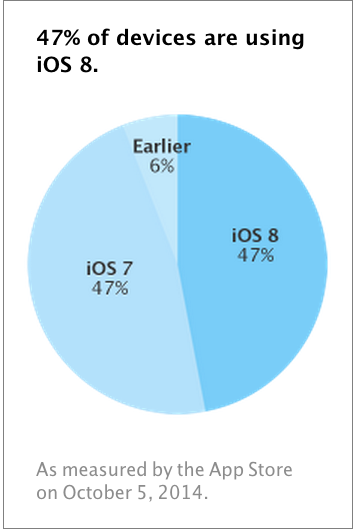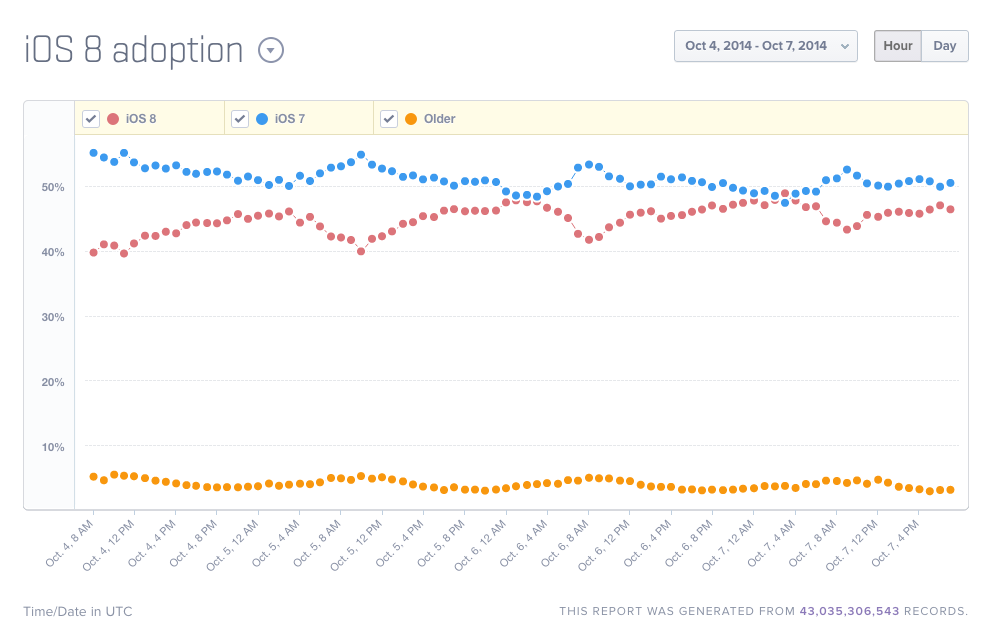When Apple released iOS 8 last month, it debuted to a lukewarm reception. According to mobile marketers, users last year installed iOS 7 twice as fast as they installed iOS 8 on the first day.
Now, Apple’s latest numbers are in. And the news is … well, still kind of mediocre.
Approximately three weeks after its release, less than half the people using an iOS device are using the new version.
See also: On Its First Day, iOS 8 Took Off More Slowly Than Its Predecessors
iOS 8 Can’t Kill iOS 7
According to Apple’s developer site, which keeps tabs on mobile software installations through the App Store, just as many people run iOS 7 as iOS 8.
Dated October 5, 2014, Apple’s pie chart shows that the two software versions take an equal share, accounting for 47% of users. Beyond that, another 6% of gadgets—likely older models that can’t handle newer software—run even earlier versions.

Citing data from analytics firm Mixpanel, MacRumors notes that, during a similar period last year, almost 70 percent of iOS users put iOS 7 on their iPhones, iPads and iPod touches.

Why the trepidation surrounding iOS 8? One look at the headlines should offer some answers.
Apple radically retooled several aspects of the iPhone software, for both the users running it and the developers making apps for it. But the revamp has been plagued by glitches.
Anything new and untested in the field can be prone to problems, and Apple’s software is no exception. People who rushed to update their devices to iOS 8.0.0 and then iOS 8.0.1 found that the software crippled calling, killed battery life and removed the Camera Roll photo folder, among other things.
See also: iOS 8.0.1 Kills More Than It Cures, So Apple Pulled It
The company moved quickly to address many of those issues in iOS 8.0.2, but it still sustained some damage to user trust. Now early adoption fever seems to have cooled, at least for half of the iPhone user base.
Making matters worse, Apple pulled the plug on iOS 7.1.2 last month. Without the previous version of the software available, users who took a chance on iOS 8 effectively found themselves stranded with it, with no official way of downgrading.
iOS 8.1: A New Hope?
Last week, developers got their hands on the new next version, iOS 8.1, which fuels speculation that it will launch very soon—likely later this month, around the time Apple unveils its new iPads.
The update should come with even more bug fixes, as well as the much-anticipated Apple Pay, the all-new mobile payments system introduced at Apple’s September press event.
See also: Apple Has Reportedly Forced Banks To Stop “Taxing” Mobile Payments
That could help move the needle on iOS 8 installations. But there’s an equal chance that, faced with the prospect of yet another brand-new technology that hasn’t been battle-tested yet, bug-weary iPhone users may decide to wait.
Because it would take an enormous leap of faith for people to hand over their financial data—especially to a company with a spotty track record in rolling out new things.

When it comes to mobile, Apple has had as many stumbles as hits over the years. For all its glorified successes with the first iPod, the iPhone and the conception of the App Store, it also caught heat for half-baked functions like Siri and Apple Maps, not to mention the iPhone 4 “antennagate” PR nightmare.
Now with iOS 8, there’s a new pile of problems to add to Apple’s hall of shame. And those problems aren’t entirely in the rearview mirror yet.
If Apple wants people using their iPhones as wallets, the company will need to make sure its software is bulletproof. And along with fixing bugs, it will also need to fix something else: the damaged trust that’s still keeping people away from iOS 8.
That, we suspect, might be much harder.
Lead photo by Adriana Lee for ReadWrite. Apple Pay screenshot by Stephanie Chan for ReadWrite









